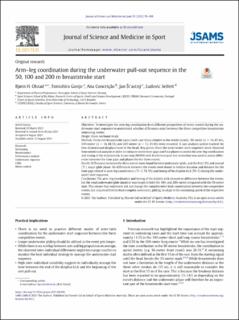| dc.contributor.author | Olstad, Bjørn Harald | |
| dc.contributor.author | Gonjo, Tomohiro | |
| dc.contributor.author | Conceição, Ana | |
| dc.contributor.author | Šťastný, Jan | |
| dc.contributor.author | Seifert, Ludovic | |
| dc.date.accessioned | 2022-03-20T13:33:13Z | |
| dc.date.available | 2022-03-20T13:33:13Z | |
| dc.date.created | 2021-09-13T11:15:23Z | |
| dc.date.issued | 2022 | |
| dc.identifier.citation | Journal of Science and Medicine in Sport. 2021, 25(1), Side 95-100. | en_US |
| dc.identifier.issn | 1440-2440 | |
| dc.identifier.uri | https://hdl.handle.net/11250/2986292 | |
| dc.description | This is an open access article under the CC BY license (http://creativecommons.org/licenses/by/4.0/). | en_US |
| dc.description.abstract | Objectives: To investigate the arm–leg coordination from different perspectives of motor control during the underwater start sequence to understand whether differences exist between the three competitive breaststroke swimming events.
Design: Cross-sectional study.
Methods: Forty-one breaststroke races (with race times relative to the world record): 50-meter (n = 14, 87.6%), 100-meter (n = 14, 88.5%) and 200-meter (n = 13, 85.4%) were recorded. A race analysis system tracked the two-dimensional displacement of the head. Key points from the underwater start sequence were obtained from notational analysis in order to compute seven time-gaps and four phases to assess the arm–leg coordination and timing of the dolphin kick. A one-way ANOVA with Bonferroni post-hoc correction was used to assess differences between the time gaps and phases for the three events.
Results: Differences between the three events were found for total underwater glide, and the first (T0) and second (T1) major glide phase. No differences between the events were found in relative duration and distance for the time gaps related to arm–leg coordination (T1–3, T4, T6) and timing of the dolphin kick (T4–5) during the underwater start sequence.
Conclusions: The arm–leg coordination and timing of the dolphin kick showed no difference between the events, but the total underwater glide duration was longer in both the 100- and 200-meter compared with the 50-meter start. This shows that swimmers did not change the complex inter-limb coordination between the competitive events, but only modified the least complex movement, gliding, to adapt to the swimming speed of the respective events. | en_US |
| dc.language.iso | eng | en_US |
| dc.subject | biomechanics | en_US |
| dc.subject | glide | en_US |
| dc.subject | motor control | en_US |
| dc.subject | performance analysis | en_US |
| dc.subject | swimming | en_US |
| dc.subject | underwater sequence | en_US |
| dc.title | Arm–leg coordination during the underwater pull-out sequence in the 50, 100 and 200 m breaststroke start | en_US |
| dc.type | Peer reviewed | en_US |
| dc.type | Journal article | en_US |
| dc.description.version | publishedVersion | en_US |
| dc.rights.holder | © 2021 The Authors | en_US |
| dc.source.pagenumber | 95-100 | en_US |
| dc.source.volume | 25 | en_US |
| dc.source.journal | Journal of Science and Medicine in Sport | en_US |
| dc.source.issue | 1 | en_US |
| dc.identifier.doi | 10.1016/j.jsams.2021.08.006 | |
| dc.identifier.cristin | 1933685 | |
| dc.description.localcode | Institutt for fysisk prestasjonsevne / Department of Physical Performance | en_US |
| cristin.ispublished | true | |
| cristin.fulltext | original | |
| cristin.qualitycode | 1 | |
